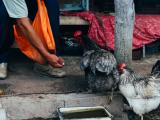Aug 22, 2007 (CIDRAP News) – A 28-year-old woman on the Indonesian resort island of Bali died yesterday of H5N1 avian influenza, marking the second fatal case there this month, according to Indonesian health officials.
Also today, the US Centers for Disease Control and Prevention (CDC) confirmed that it has received from Indonesia a sample from the woman who had the first reported H5N1 infection on Bali, a 29-year-old who died of the disease on Aug 12.
Joko Suyono of the health ministry's avian flu information center said the woman who died yesterday worked for a chicken trader, and authorities suspect she was exposed to infected poultry at work, the Associated Press (AP) reported. She had been hospitalized 4 days at the time of her death.
Suyono said tests from two laboratories showed the woman had the virus, according to reports from the Associated Press (AP) and Agence France-Presse.
The health ministry said it was determined yesterday that several chickens at the woman's workplace were infected with H5N1, the AP reported. The ministry gave no information on whether infected poultry might have been sold before the tests.
With the latest case, Indonesia has had 105 human H5N1 cases and 84 deaths. The World Health Organization has not yet recognized the case and lists Indonesia's count as 104 cases with 83 deaths.
No human H5N1 cases had been reported on Bali until the 29-year-old woman died of the disease there on Aug 12. She was from the Jembrana district, which officials said is far from the major tourist sites and has avian flu in poultry.
Indonesia said last week it was sending a sample from the 29-year-old to the CDC, ending the country's prolonged withholding of human H5N1 samples from the World Health Organization (WHO). The CDC is a WHO collaborating center.
Curtis Allen, a CDC spokesman in Atlanta, confirmed today that the agency received two samples from Indonesia. He said the results of tests by the CDC would be announced by the Indonesian government.
In an Aug 20 statement, Indonesia's avian flu committee said it had sent the CDC samples from the 29-year-old Bali woman and a 2-year-old girl, also from Bali, who had a suspected case but had tested negative for H5N1. The statement said the CDC had already confirmed the findings from the Indonesian labs regarding the two patients.
Allen told CIDRAP News today, "I can confirm that we did receive those two samples and those are the two samples we tested. Indonesia would be the ones who would release the information on the results."
Previous reports mentioned a 2-year-old girl with suspected avian flu who was a neighbor of the 29-year-old woman. The Indonesian statement did not make clear whether the girl survived. The woman also had a 5-year-old daughter who died of pneumonia on Aug 3, but she was not tested for H5N1, according to previous reports.
Indonesia stopped sending H5N1 patient samples to the WHO last December as a protest against what it considered the unaffordable cost of commercial vaccines derived from the samples. The WHO is trying to hammer out guidelines for sharing of flu viruses that will satisfy the concerns of Indonesia and other developing countries.
The Aug 20 statement from Indonesia said H5N1 virus from the samples submitted to the CDC would be genetically sequenced in the next 2 to 3 weeks. The statement predicted that the sampling would show that the virus has not mutated to a more dangerous form, thereby signaling that Bali is safe to visit.



















